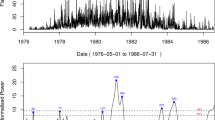Abstract—
We applied a new approach to measure the time delays of magnetohydrodynamic waves propagating in the solar atmosphere. A small flare in the flare region of the chromosphere served as a modulator of 3‑ and 5-minute oscillations. The oscillation amplitude increased several times, which made it possible to easily fix the wave train formed as it spread upward through the solar atmosphere layers. Such a short-term and well-defined wave train serves as a convenient tool for determining the velocity of propagating magnetohydrodynamic waves, since it avoids the uncertainties in the measurement of the phase shift that arise under ordinary conditions. The advantage of using amplitude modulation from a small flare is that it makes it possible to study the atmosphere of the Sun under conditions close to those in an unperturbed atmosphere.




Similar content being viewed by others
REFERENCES
R. G. Giovanelli, J. W. Harvey, and W. C. Livingston, Solar Phys. 58, 347 (1978).
M. von Uexkull, F. Kneer, and W. Mattig, Astron. Astrophys. 123, 263 (1983).
B. W. Lites, Astrophys. J. 277, 874 (1984).
B. W. Lites and J. H. Thomas, Astrophys. J. 294, 682 (1985).
N. I. Kobanov, D. Y. Kolobov, and D. V. Makarchik, Solar Phys. 238, 231 (2006).
R. Centeno, M. Collados, and J. Trujillo Bueno, Astrophys. J. 692, 1211 (2009); arXiv: 0810.3613.
N. I. Kobanov and V. A. Pulyaev, Solar Phys. 268, 329 (2011); arXiv: 1110.1444.
N. Kobanov, D. Kolobov, A. Kustov, S. Chupin, and A. Chelpanov, Solar Phys. 284, 379 (2013); arXiv: 1302.5164.
G. B. Gelfreikh, Y. T. Tsap, Y. G. Kopylova, T. B. Goldvarg, Y. A. Nagovitsyn, and L. I. Tsvetkov, Astron. Lett. 30, 489 (2004).
Y. T. Tsap, A. V. Stepanov, and Y. G. Kopylova, Solar Phys. 291, 3349 (2016).
A. A. Chelpanov and N. I. Kobanov, Solar Phys. 293, 157 (2018); arXiv: 1810.10153.
N. I. Kobanov, Instrum. Exp. Tech. 44, 524 (2001).
J. Rayrole, Ann. Astrophys. 30, 257 (1967).
J. R. Lemen, A. M. Title, D. J. Akin, P. F. Boerner, C. Chou, J. F. Drake, D. W. Duncan, C. G. Edwards, F. M. Friedlaender, G. F. Heyman, et al., Sol. Phys. 275, 17 (2012).
P. H. Scherrer, J. Schou, R. I. Bush, A. G. Kosovichev, R. S. Bogart, J. T. Hoeksema, Y. Liu, T. L. Duvall, J. Zhao, A. M. Title, et al., Sol. Phys. 275, 207 (2012).
R. P. Lin, B. R. Dennis, G. J. Hurford, D. M. Smith, A. Zehnder, P. R. Harvey, D. W. Curtis, D. Pankow, P. Turin, M. Bester, et al., Sol. Phys. 210, 3 (2002).
V. M. Nakariakov, E. Verwichte, D. Berghmans, and E. Robbrecht, Astron. Astrophys. 362, 1151 (2000).
E. O’Shea, K. Muglach, and B. Fleck, Astron. Astrophys. 387, 642 (2002).
N. Kobanov, A. Chelpanov, and V. Pulyaev, J. Atmos. Sol.-Terr. Phys. 173, 50 (2018); arXiv: 1712.10117.
N. I. Kobanov and A. A. Chelpanov, Sol. Phys. 294, 58 (2019); arXiv: 1904.11142.
H. Kwak, J. Chae, D. Song, Y.-H. Kim, E.-K. Lim, and M. S. Madjarska, Astrophys. J. Lett. 821, L30 (2016); arXiv: 1604.02252.
ACKNOWLEDGMENTS
Spectral data were recorded at the Angara Multiaccess Center facilities at the Institute of Solar-Terrestrial Physics of Siberian Branch of Russian Academy of Sciences. We thank the NASA/SDO science team for providing the magnetic field data. We are grateful to the anonymous referee for useful suggestions.
Funding
This work was supported by the Russian Foundation for Basic Research, project no. 20-32-70076 and by the Projects No. II.16.3.2 of Institute of Solar-Terrestrial Physics of Siberian Branch of Russian Academy of Sciences.
Author information
Authors and Affiliations
Corresponding author
Additional information
Translated by E. Seifina
Rights and permissions
About this article
Cite this article
Chelpanov, A.A., Kobanov, N.I. Three- and Five-Minute Oscillations Modulated by Flares as a Means of Solar Atmosphere Sensing. Astron. Rep. 64, 363–368 (2020). https://doi.org/10.1134/S1063772920030026
Received:
Revised:
Accepted:
Published:
Issue Date:
DOI: https://doi.org/10.1134/S1063772920030026




